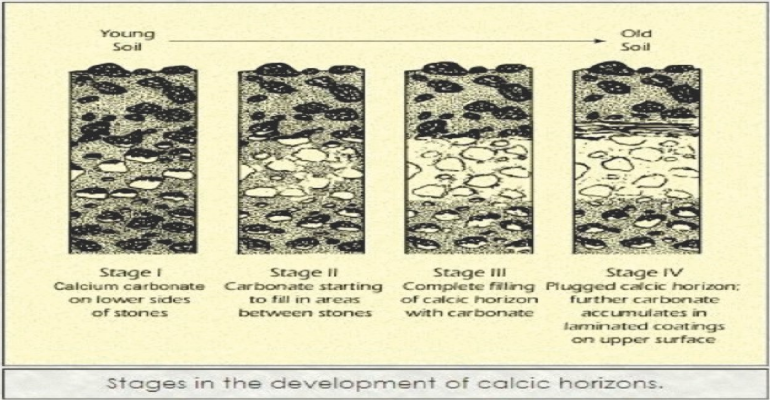
If you try to dig a hole in your yard in Tucson, chances are that you will soon hit a very hard, almost impenetrable layer.
The term “caliche” is a colloquial word that means different things in different places. In the Sonoran Desert, it means a mixture of gravel, sand, clay and other desert debris cemented by porous calcium carbonate and is more properly called a calcic horizon. These calcic horizons generally occur two to four feet below the surface and can be inches to many feet thick. Caliche forms only in arid and semi-arid areas. In Tucson, with an average annual rainfall of 10 to 12 inches, caliche forms more than ten inches below the surface. In contrast, in Yuma, which receives about four inches of rain annually, caliche may form at the surface or just a few inches below the surface.
According to the Arizona-Sonora Desert Museum:
“Thick, strongly-cemented calcic horizons take a long time to form. They start as thin, patchy coats of whitish calcium carbonate on the lower surfaces of pebbles and small stones. In fine-grained parent materials, such as dune sand, that lack coarse materials, calcium carbonate first appears as thin, white, thread-like accumulations where small roots have extracted soil water and caused the calcium carbonate to precipitate. These weakly-developed calcic horizons can form within a few thousand years. Accumulation of more calcium carbonate eventually produces thicker, continuous coatings on pebbles and stones or pronounced whitish nodules in fine-grained parent materials. Eventually, additional accumulation of calcium carbonate fills the soil interstices between pebbles or nodules and the calcic horizon becomes plugged, greatly restricting the downward movement of water. Once this occurs, calcium carbonate may continue to accumulate on the top of the calcic horizon in hard, cemented layers and may literally engulf and obscure overlying soil horizons in the process. It takes many tens to hundreds of thousands of years for such strongly-developed calcic horizons to form.” See diagram. (Source)

Caliche can form in soil developed from rocks that have little or no calcium carbonate. The calcium carbonate is derived from dust in the atmosphere and from calcium carbonate dissolved in rainwater. Dust that falls on the ground is gradually dissolved as the slightly acidic rainwater penetrates the surface. Calcium carbonate precipitates out of solution as the soils dry and provides the cement to hold the soil particles together to form the concrete-like calcic horizon.
In very arid regions, calcium sulfate (gypsum) and sodium chloride (salt) is formed instead of calcium carbonate. In the Atacama Desert of Chile, caliche also contains sodium nitrate and potassium nitrate. Nitrate, a major ingredient of explosives, was mined and exported to Europe. The importance of this source of nitrate lead to naval battles between Germany and England at the start of WWI. (Source)
In many parts of the world, caliche is used as road pavement or underlayment. It is also used as a source of calcium for manufacture of cement.
The ancient Mayan culture used caliche for building construction.
Caliche layers can be a problem for agriculture and gardening, mainly by preventing drainage. The University of Arizona College of Agriculture has some helpful advice here. Basically they recommend that if you can’t dig through all of the caliche, at least punch some drainage holes in it.
Related:
Desert Varnish and its life forms
Geology of Kitty Litter
Note to readers: I have constructed a linked index to more than 400 of my ADI articles. You can see it at: https://wryheat.wordpress.com/adi-index/
You can read my comprehensive, 28-page essay on climate change here: http://wp.me/P3SUNp-1bq
